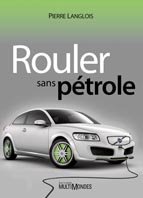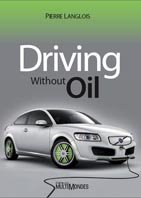
ILLUSTRATION - Artistic View of a high speed monorail equipped with wheel-motors, as designed by Pierre Couture at the beginning of the years 1990s. Illustration taken from my latest book «Rouler sans pétrole»(Driving without oil). (Drawing: Paul Berryman)
The author of this blog who has lived in France for two years knows how much the TGV (from the French expression «Train à Grande Vitesse», High Speed Train) are comfortable and faster than the plane for travels of less than 1000 km, taking into account the loss of time at airports and between airports and city centers.
But the establishment of a high speed railroad line costs around 15 million euros/km (15 M€/km) in France, or 23 M CDN $/km (29 M US $/mile). In the Nordic countries such as Canada, it is necessary to have deeper foundations for the railroads in the event of freezing and thawing, and the bill could climb to more than 30 M CDN $/km (37 M US $/mile). The cost of a high-speed train between two cities 250 km (156 miles) apart could very well exceed 7.5 billion CDN $ (5.8 billion US $). To make such infrastructures worth it requires a high population density, while in countries like Canada there are few populous cities far apart.
This problem of fast interurban transportation was the subject of much thoughts from Pierre Couture, the inventor of modern wheel-motor (with the Institut de Recherche d'Hydro-Quebec in 1994). It led him to a concept quite revolutionary. Judge for yourself.
To minimize the foundation works for the tracks which must be resistant to frost, the solution proposed by Pierre Couture is to build a lightweight monorail with two lanes suspended to the same structure, itself supported by poles every 60 meters (180 feet) or so. The self-propelling cars, suspended and powered by 16 wheel-motors, are capable of carrying sixty passengers and travel apart from each other at a speed of 250 km/hour (155 miles/hour).
To avoid having to expropriate land for the lines, the monorails are constructed between the two lines of a highway. The surfaces used on the ground are just a few square meters every sixty meters. For tight turns, it would suffice to overflow slightly plots and tilt the rails. Since the wheels are equipped with rubber tires, they offer a better grip than the iron wheels of trains, allowing the monorail to climb the slopes of highways and step over crossing bridges. The I beam on which the motorized wheels roll is embodyed from the top by a light enclosure, that protects the rail-beam from snow falls.
When you think of it, this light and fast monorail would greatly benefit all over the world, not only in cold countries. Especially as the cost of infrastructure is at least 3 times lower than that of a TGV (High Speed Train), given the little work done with the ground, the absence of expropriation, and construction of structures in automated factories, 12 months a year ! We could develop these monorails only with the money saved by introducing a line of 250 km, since this line would cost about $ 5 billion less than a TGV! Thereafter, the commercialization of this technology would quickly recover the investment.
These light and fast monorails would also be ideal for connecting downtowns to airports, or for people transit across a river to reduce the traffic congestions on bridges at rush hour. We only have to hang the monorail guiding lines on the side structures of bridges. Such a service of public transportation is much less expensive than a subway under the river.
Who will do it?





I stumbled on your blog while looking at monorail pages on the www, currently I doing a Project (just a unreal project sorry) for my course about Project Management, I like monorails and believe many cities around the world will have new monorails in the future, as more people need to use public transport networks and these are basically the only option for cities as the tracks can be put above roads, even houses. The only other option is to put track below the ground which costs much, much more.... Anyway thanks for your blog...
ReplyDelete